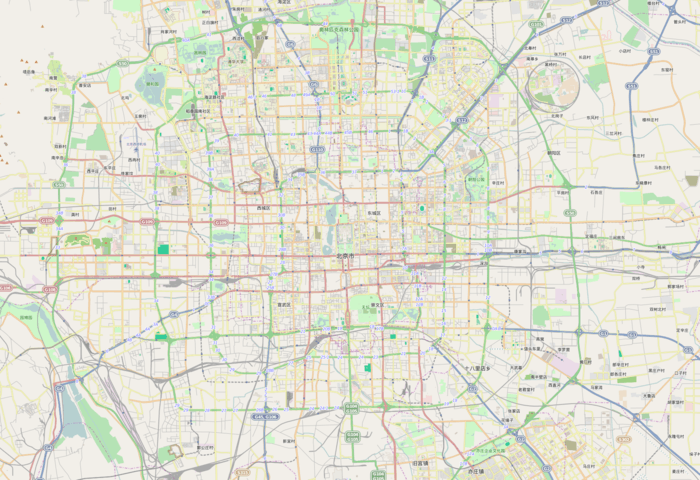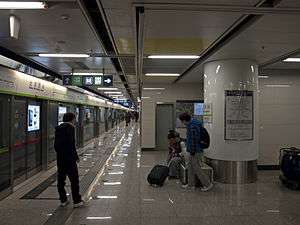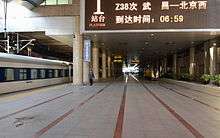Beijing West railway station
Beijingxi (Beijing West) railway station (Chinese: 北京西站; pinyin: Běijīngxī Zhàn), colloquially referred to as West Station (Chinese: 西客站), is located in western Beijing's Fengtai District. Opened in early 1996 after three years of construction, it was the largest railway station in Asia with an area of 510,000 m2,[1][2] before being surpassed by Shanghai Hongqiao railway station in platform capacity. The station serves in average 150,000–180,000 passengers per day with a maximum of 400,000 people per day.[3] It was expanded in 2000 and had a vast number of parking spaces added.
Beijingxi 北京西 | |
|---|---|
.jpg) Beijing West Station in June 2018 | |
| Other names | Beijing West |
| Location | 118 Lianhuachi Donglu, Fengtai District, Beijing China |
| Coordinates | 39°53′42″N 116°19′19″E |
| Operated by | |
| Connections | Bus terminal |
| History | |
| Opened | |
| Location | |
 Beijingxi Location in central Beijing | |
.jpg)
Overview
The construction concept of Beijing West railway station began as early as 1959. It was planned and researched three times in history, but the first two were put on hold for political and economic reasons. For the third time, in 1989, the preparatory work, adjustment planning, and re-reporting were resumed and finally approved by the state. Beijing West railway station project was jointly funded by the Beijing Municipal Government and the Ministry of Railways. It was a key project in China's eighth five-year plan with a total investment of 6.5 billion yuan.
After the completion of the Beijing West railway station, the passenger pressure at the Beijing railway station was greatly alleviated. Beijing West station is the passenger train departure station of Beijing–Guangzhou high-speed railway, the two main railway lines in China: Beijing–Guangzhou railway (connected via the Beijing-Guangzhou railway west long link) and the Beijing–Kowloon railway, and a high-speed railway line. Most passenger trains in China's Central South, South China, Southwest, and Northwest China depart from Beijing West Railway Station. As of May 2011, Beijing West Railway Station had received more than 110 trains per day, of which about 100 departed. The Beijing underground cross-city railway, which passes through the urban area of Beijing and connects to Beijing railway station, was opened to traffic on March 20, 2015.
Beijing Railway Station is one of the transportation hubs in Beijing. There are bus hubs in North Square and South Square. A large number of buses depart from there; a taxi rank is also built underground; and the subway station reserved for construction has been completed by the end of 2011, a transfer station between Line 7 and Line 9.
Beijing West Railway Station's architectural style, building quality, design and planning have been criticised and controversial since its opening, but despite this, the station is still one of Beijing's most eye-catching buildings. At the end of 2007, the “Beijing New Landmarks Selection” event sponsored by the Beijing News announced the top ten new landmarks in Beijing after the public vote in January 2008. Beijing West Railway Station unexpectedly took 51,335 votes, second only to the National Stadium, becoming the new landmark in Beijing with the second most votes.
History
Background
As early as the 1950s, the concept of building the second passenger-railway station for Beijing and the underground diameter line had been formed. In the autumn of 1959, when the Beijing Railway Station, one of the “Ten Great Buildings” erected in celebration of the 10th anniversary of the National Day of the People's Republic of China, was just completed, the then Premier of the State Council, Zhou Enlai, during the process of reviewing the planning of Beijing’s railway, affirmed the suggestion of a west passenger station in Beijing. In the general layout of the Beijing Railway Hub revised in September 1960, the idea at the time was to use Beijing West Railway Station and Beijing Railway Station as the main passenger terminal of the hub, and may connect the two major stations through the center of Beijing through four parallel underground tunnels. The site of the West Railway Station is directly opposite the Gongzhufen (Tomb of the Princess). The Beijing Municipal Government has correspondingly reserved land for the lotus pond that was still in the suburbs in the urban master plan. Therefore, for a long period of time thereafter, the lotus pond area has been a warehouse area dominated by simple bungalows. No permanent building has been constructed. However, due to the reduction in the scale of construction during the three-year difficult period, the planning has not made much progress. The subsequent start of the Cultural Revolution led to the suspension of the overall urban planning work in Beijing and the cancellation of the planning agency.
Planning
The first plan (1975-76)
In January 1975, the first session of the 4th National People's Congress was convened. Deng Xiaoping was elected Vice Premier of the State Council and began to preside over the daily work of the Central Committee and the State Council; Wan Li was then appointed as the Minister of Railways, responsible for rectifying the chaotic railway transportation system at that time; In March, the "Decision of the Central Committee of the Communist Party of China on Strengthening Railway Work" was issued as a mobilization order for the comprehensive rectification of the railway, and it soon achieved results, and then proposed to build the Beijing West railway station again. At that time, the railway department and planning department were still very vague about the location and construction plan of Beijing West railway station. There was no detailed design before, and whether the planned underground diameter line was retained or not, and the technical plan was not finalized, resulting in the design of Beijing West railway station. It is difficult to decide whether to choose through or end. As agreed by the Ministry of Railways and the Beijing Municipal Government, it was decided to jointly establish a planning working group to be responsible for researching and selecting the site and construction plan of the West Railway Station. The Third Design Institute of the Ministry of Railways (now China Railway Design Group Co., Ltd.) and Beijing Architectural Design Institute (Now Beijing Architectural Design and Research Institute Co., Ltd.) were responsible for specific technical work.
After some investigation, comparison and discussion, the planning working group came up with the preliminary plan for Beijing West railway station in November 1975 and determined that the Beijing West station was a pass-through station. The station's site is located at the southwest corner of Lianhua Bridge. The road runs northwest-southeast, adopts a triangular square, and the station faces the center of the overpass. However, the political situation changed again soon after, affected by the "Counterattack the Right-Deviationist Reversal-of-Verdicts Trend" in 1976, and the site plan was shelved without approval.
Services
China Railway
| Other names | Beijing West | ||||||||||||||||||||||||||||||||||||||||||||||||||||
|---|---|---|---|---|---|---|---|---|---|---|---|---|---|---|---|---|---|---|---|---|---|---|---|---|---|---|---|---|---|---|---|---|---|---|---|---|---|---|---|---|---|---|---|---|---|---|---|---|---|---|---|---|---|
| Location | 118 Lianhuachi Donglu, Fengtai District, Beijing China | ||||||||||||||||||||||||||||||||||||||||||||||||||||
| Operated by | China Railway | ||||||||||||||||||||||||||||||||||||||||||||||||||||
| Line(s) | Beijing–Guangzhou Railway Beijing–Kowloon Railway Beijing–Guangzhou–Shenzhen–Hong Kong High-Speed Railway Beijing–Xiong'an intercity railway Beijing Underground Cross City Railway Sub-Central line (Beijing Suburban Railway) | ||||||||||||||||||||||||||||||||||||||||||||||||||||
| Platforms | 18 | ||||||||||||||||||||||||||||||||||||||||||||||||||||
| Tracks | 20 | ||||||||||||||||||||||||||||||||||||||||||||||||||||
| Other information | |||||||||||||||||||||||||||||||||||||||||||||||||||||
| Station code | TMIS code: 21152 Telegram code: BXP Pinyin code: BJX | ||||||||||||||||||||||||||||||||||||||||||||||||||||
| Classification | Top Class station | ||||||||||||||||||||||||||||||||||||||||||||||||||||
| History | |||||||||||||||||||||||||||||||||||||||||||||||||||||
| Opened | 21 January 1996 | ||||||||||||||||||||||||||||||||||||||||||||||||||||
| Services | |||||||||||||||||||||||||||||||||||||||||||||||||||||
| |||||||||||||||||||||||||||||||||||||||||||||||||||||
Beijing West railway station is a terminal for both "traditional" and high-speed trains. It is the Beijing terminal for most trains leaving the city for destinations in western and southwestern China, including Xi'an, Chongqing, Chengdu, Lhasa and Urumqi. Major "traditional" rail lines beginning at this station include the Beijing-Guangzhou Railway (via Wuhan) and the Beijing-Kowloon Railway (via Nanchang and Shenzhen).
Beijing West is the terminal both for the Beijing-Kowloon Through Train and (since the opening of the Qingzang railway in 2006) for the Beijing-Lhasa trains.
Beijing West is the northern terminal of the Beijing-Guangzhou High-Speed Railway as of December 2012. High-speed trains leave the station for Guangzhou and Shenzhen, as well as various destinations on the connecting lines, such as Taiyuan and Xi'an. There are, however, plans to construct new major railway terminal (the new Fengtai railway station) in the southwestern part of Beijing, and to eventually make it the terminal for the high-speed trains on the Beijing-Guangzhou line.
The Beijing underground cross-city railway connects Beijing West with Beijing railway station.
Destinations
| Carriers | Destinations |
|---|---|
| CR Beijing | Baoji South, Changsha South, Changchun, Chengde, Chongqing, Dajian, Guangzhou South, Guiyang North, Handan, Handan East, Hengshui, Nanchang West, Nanning East, Qinhuangdao, Shenzhen, Shenzhen North, Shijiazhuang, Shijiazhuang North, Taiyuan South, Wuhan, Xi'an, Xi'an North, Xining, Yichang East, Yinchuan, Yuncheng North, Zhangjiakou South, Zhuhai |
| CR Chengdu | Chengdu, Chengdu East, Chongqing North, Guiyang, Guiyang North, Panzhihua |
| CR Guangzhou | Changsha South, Guangzhou, Guangzhou East, Hong Kong West Kowloon, Hung Hom, Sanya, Shenzhen, Shenzhen North |
| CR Harbin | Harbin, Lhasa |
| CR Hohhot | Baotou, Dongsheng West, Guangzhou, Hohhot, Tianjin, Wuhai West |
| CR Kunming | Kunming |
| CR Lanzhou | Lanzhou, Yinchuan |
| CR Nanchang | Fuzhou, Ganzhou, Jinggangshan, Nanchang, Nanchang West, Shijiazhuang, Xiamen |
| CR Nanning | Guilin North, Nanning, Nanning East, Zhanjiang |
| CR Qingzang | Xining |
| CR Shanghai | Anqing, Fuyang, Huangshan |
| CR Shenyang | Changchun, Lhasa, Shenyang North |
| CR Taiyuan | Linfen West, Taiyuan South, Yongji North, Yuncheng North |
| CR Ürümqi | Ürümqi South |
| CR Wuhan | Enshi, Hankou, Shiyan, Wuchang, Wuhan, Yichang East, Zhoukou |
| CR Xi'an | Baoji, Baoji South, Hanzhong, Tianjin, Xi'an, Xi'an North |
| CR Zhengzhou | Changzhi North, Hankou, Luoyang, Nanyang, Xi'an North, Zhengzhou, Zhengzhou East |
Beijing Subway
 Line 9 platforms | ||||||||||||||||
| Operated by | Beijing Subway | |||||||||||||||
| Line(s) | ||||||||||||||||
| Platforms | 4 (2 island platforms) | |||||||||||||||
| History | ||||||||||||||||
| Opened | December 28, 2014 (Line 7) December 31, 2011 (Line 9) | |||||||||||||||
| Services | ||||||||||||||||
| ||||||||||||||||
- This station is served by Line 7 and Line 9. Passengers are able to change between Line 7 and Line 9 using the cross-platform interchange method. The Subway concourse is on the Arrivals level, with all platforms a level further below.
Exits
| Exit | Destination | ||
|---|---|---|---|
| Beijing West Railway Station, North Cellular Community, Beijing Zhongyu Century Hotel, Lianhuachi East Rd., Yangfangdian Rd., Ximulou Community, Tiexi Residential Community | |||
| Beijing West Railway Station,, Guanglian Rd,, Beijing Meteorological Hotel, Maliandao North Rd,, Beijing West Railway Station South Rd., Lianhuachi Park, Jiji Hotel, Jinjiang Inn, Lishui Lotus Community |
Beijing Bus
- Beijing Bus stops:
- Beijing West Station (北京西站): 9, 21, 40, 47, 50, 52, 54, 65, 67, 83, 89, 99, 205, 209, 212, 213, 301, 319, 320, 373, 374, 387, 414, 437, 616, 623, 661, 662, 663, 673, 694, 695, 741, 840, 843, 845, 901, 特2, 特6, 运通102
- Beijing West Station South Square (北京西站南广场): 53, 72, 109, 122, 309, 349, 410, 616, 820, 890, 941, 982, 993,
- Beijing Airport Bus: Route 7
Bus route numbers in bold denotes terminus at the stop.
Station layout
China Railway
Regular rail services leave from Platforms 1-11; HSR leaves from Platforms 12-18. A dedicated exit is used for passengers arriving on Platform 18.


| North | ||
| Platform 1 | ||
| Track 1 | ||
| Track 2 | ||
| Platform 2 Platform 3 | ||
| Track 3 | ||
| Track 4 | ||
| Platform 4 Platform 5 | ||
| Track 5 | ||
| Track 6 ←Beijing-Guangzhou Railway —— Beijing-Kowloon Railway→ | ||
| Track 7 | ||
| Platform 6 Platform 7 | ||
| Track 8 | ||
| Track 9 | ||
| Platform 8 Platform 9 | ||
| Track 10 | ||
| Track 11 (Xichang Railway, Beijing-Kowloon Railway) | ||
| Track 12 (South of this track Beijing–Guangzhou–Shenzhen–Hong Kong High-Speed Railway) | ||
| Platform 10 Platform 11 | ||
| Track 13 | ||
| Track 14 | ||
| Platform 12 Platform 13 | ||
| Track 15 | ||
| Track 16 | ||
| Platform 14 Platform 15 | ||
| Track 17 | ||
| Track 18 | ||
| Platform 16 Platform 17 | ||
| Track 19 | ||
| Track 20 | ||
| South | Platform 18 | |
All passengers will leave Beijing West from the Level 2 Departures Hall, except for passengers to Hong Kong, who must enter from a dedicated entrance with immigration and customs clearance facilities located by North Entrance 1. These passengers will clear customs and immigration at Beijing West and will not leave the train until it arrives at the Kowloon / Hung Hom terminus in Hong Kong. A VIP lounge is available for Business Class passengers travelling HSR.
Ticket counters and machines are available beside the main entrances.
Beijing Subway
| B1 | Concourse | Access to Beijing West station, Faregates, Station Agent |
| B2 | Northbound | ← Line 9 towards National Library (Military Museum) |
| Westbound | ← Line 7 termination track | |
| Eastbound | → Line 7 towards Hua Zhuang (Wanzi) → | |
| Southbound | → Line 9 towards Guogongzhuang (Liuliqiao East) → | |
.jpg)
References
- Rough Guide to China - fifth edition, page 83
- "Shanghai to have Asia's largest railway station". Xinhua. 10 August 2006. Retrieved 15 May 2010.
- "Archived copy". Archived from the original on 7 January 2009. Retrieved 2009-09-13.CS1 maint: archived copy as title (link)
External links
| Wikimedia Commons has media related to Beijing West Railway Station. |
- Beijing West Railway Station (in Chinese)
- Beijing Huoche Zhan Network (in Chinese)
- Beijing Railways Time Table